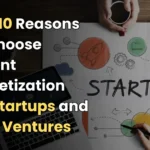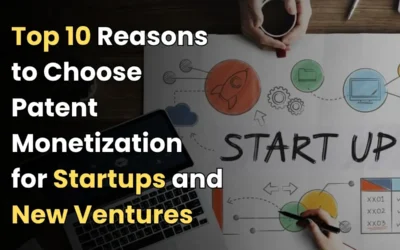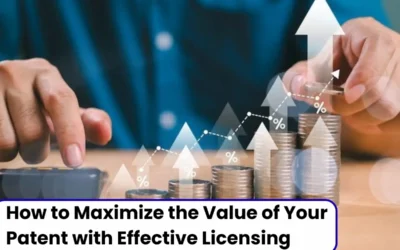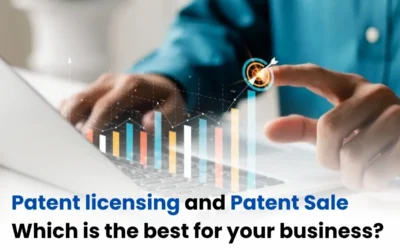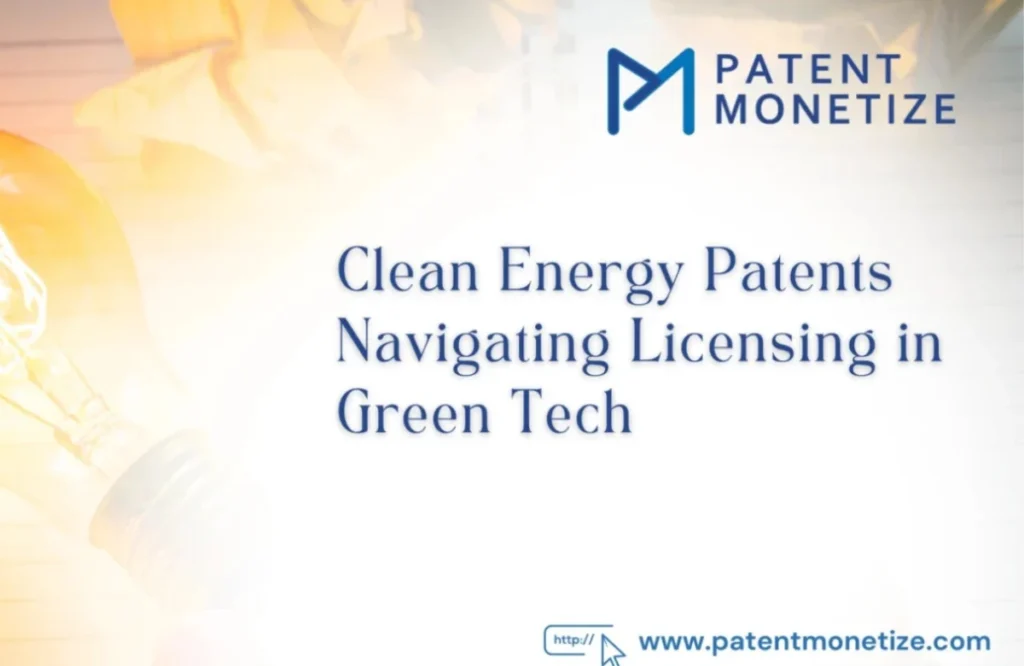
The global shift towards sustainable development and carbon neutrality has fueled innovation in clean energy technologies. Companies across sectors are investing heavily in renewable energy solutions, energy efficiency systems, and carbon reduction methods. This surge in innovation has resulted in a parallel boom in clean energy patents. For inventors and businesses, patent filing in green technology is not just a shield to protect innovations but also a valuable tool for licensing and monetization. Navigating licensing agreements in clean energy patents is vital for unlocking financial opportunities while promoting the adoption of sustainable solutions globally.
What Are The Importance of Clean Energy Patents?
Clean energy patents represent intellectual property rights (IPR) granted to innovations that promote sustainable energy production, efficiency improvements, and environmental protection. These patents protect novel technologies in areas like solar power, wind energy, hydrogen fuel cells, energy storage systems, smart grids, biofuels, and electric vehicles (EVs).
Securing a patent in clean energy provides market exclusivity, prevents competitors from copying innovations, and allows patent holders to license their technologies to third parties, generating royalty-based revenue.
What Are The Key Sectors Driving Clean Energy Patents?
1. Solar Energy
Solar technology patents dominate the clean energy landscape, covering a range of photovoltaic (PV) systems and solar thermal solutions. Patents include:
- Photovoltaic Cells: High-efficiency solar cells, perovskite solar cells, thin-film technology, multi-junction cells.
- Module Designs: Flexible solar panels, bifacial solar panels, integrated solar roofing.
- Solar Inverters: Maximum power point tracking (MPPT) inverters, hybrid inverters, microinverters.
- Solar Tracking Systems: Automated solar trackers that adjust panel angles based on sunlight.
- Solar Thermal Systems: Concentrated solar power (CSP), parabolic troughs, and heliostat systems.
- Floating Solar Systems: Patents for solar panels installed on bodies of water to maximize land use efficiency.
Read Also: Patent Monetization Fundamentals: Must Know Before Monetizing Your Patent
2. Wind Power
Wind energy patents focus on improving turbine efficiency and increasing durability. Key patent categories include:
- Turbine Blades: Aerodynamic designs, lightweight composite materials, anti-icing coatings.
- Offshore Wind Platforms: Floating wind turbines, anchoring systems, deep-water platforms.
- Generators: Direct-drive generators, permanent magnet systems.
- Control Systems: Blade pitch control, yaw systems, wind farm optimization algorithms.
- Hybrid Systems: Combining wind turbines with solar or energy storage technologies.
3. Hydrogen & Fuel Cells
As hydrogen gains prominence as a clean fuel alternative, patent filings in hydrogen production, storage, and fuel cell technology have surged. Notable patent types include:
- Hydrogen Production: Electrolysis systems, proton exchange membrane (PEM) electrolyzers, alkaline electrolyzers.
- Hydrogen Storage: Compressed hydrogen storage tanks, metal hydride storage, cryogenic hydrogen systems.
- Fuel Cell Technologies: Proton exchange membrane fuel cells (PEMFC), solid oxide fuel cells (SOFC), hydrogen fuel cell stacks for transportation and stationary power.
- Hydrogen Infrastructure: Refueling stations, hydrogen pipelines, leakage detection systems.
4. Energy Storage
Patents related to energy storage systems are critical for enabling the adoption of intermittent renewable sources like solar and wind. Storage patents cover:
- Lithium-Ion Batteries: Battery chemistry advancements, fast-charging systems, thermal management.
- Solid-State Batteries: Next-generation battery designs with improved energy density and safety.
- Flow Batteries: Vanadium redox flow batteries, zinc-bromine flow batteries for large-scale grid storage.
- Compressed Air Energy Storage (CAES): Systems that store energy as compressed air, released to generate electricity.
- Pumped Hydro Storage: Reservoir management systems, reversible pump-turbine designs.
5. Smart Grids & Grid Integration
Smart grid patents enable efficient electricity distribution and grid stability in an increasingly decentralized energy environment. Key patent areas include:
- Grid Management Systems: Real-time grid monitoring, fault detection, and self-healing grids.
- Smart Meters: Bi-directional communication systems, load management devices.
- Demand Response Technologies: Automated load shifting, time-of-use optimization.
- Distributed Energy Resources (DER) Integration: Systems that manage solar, wind, and battery inputs into the grid.
- Vehicle-to-Grid (V2G) Systems: EV batteries as grid storage, bi-directional charging systems.
6. Biofuels
Patents in biofuels aim to develop sustainable alternatives to fossil fuels by using organic matter. Common patent types include:
- Bioethanol Production: Fermentation processes, enzyme optimization.
- Biodiesel: Transesterification methods, algae-based biodiesel systems.
- Advanced Biofuels: Cellulosic ethanol, biogas upgrading, synthetic fuels from biomass.
- Waste-to-Energy Technologies: Conversion of agricultural and municipal waste into biofuels.
7. Electric Vehicles (EVs)
EV patents are transforming the transportation sector by driving battery innovations and vehicle performance improvements. Patent categories include:
- Battery Technologies: Lithium-ion, lithium-sulfur, solid-state batteries, battery thermal management.
- Electric Powertrains: Electric motors, regenerative braking, power inverters.
- Charging Infrastructure: Fast-charging stations, wireless charging systems, ultra-fast DC chargers.
- Autonomous EV Systems: Energy-efficient navigation, smart routing for EVs.
- Battery Recycling: Patents for extracting lithium, cobalt, and other metals from used batteries.
8. Carbon Capture and Utilization
Patents in carbon capture, utilization, and storage (CCUS) focus on reducing greenhouse gas emissions from industrial processes and power generation:
- Post-Combustion Capture: Amine-based solvents, membrane separation.
- Pre-Combustion Capture: Integrated gasification combined cycle (IGCC) systems.
- Direct Air Capture: Chemical absorption, solid sorbents.
- Carbon Utilization: Converting captured CO2 into fuels, chemicals, and building materials.
9. Geothermal Energy
Geothermal patents target harnessing heat from beneath the Earth’s surface. Patent areas include:
- Enhanced Geothermal Systems (EGS): Fracturing techniques, deep-well drilling.
- Binary Cycle Power Plants: Heat exchangers, working fluid improvements.
- Geothermal Heat Pumps: Subsurface heat exchangers, smart thermal management.
10. Ocean Energy
Patents in wave and tidal energy focus on harnessing ocean power for electricity production:
- Wave Energy Converters (WEC): Oscillating water columns, point absorbers.
- Tidal Stream Systems: Underwater turbines, floating tidal platforms.
- Thermal Gradient Systems: Ocean Thermal Energy Conversion (OTEC) designs.
What Does It Mean to License Clean Energy Patents?
Patent licensing in clean energy technologies enables patent holders to generate revenue while ensuring broad technology adoption to address global environmental challenges. Licensing can be exclusive, non-exclusive, or cross-licensing, depending on the parties involved and market strategy.
Types of Licensing Agreements
- Exclusive License: An exclusive license refers to the provision of rights to use intellectual property within a specific field and Territory. This often comes with higher royalty fees and long-term commitments.
- Non-Exclusive License: Allows multiple parties to use the patented technology, increasing widespread adoption while ensuring steady revenue streams.
- Cross-Licensing: Involves two companies exchanging patent rights, promoting collaboration, and reducing litigation risks.
Benefits of Licensing Clean Energy Patents
- Revenue Generation: Patent holders earn royalty payments from licensees.
- Technology Diffusion: Licensing promotes widespread adoption of sustainable innovations.
- Partnerships & Collaborations: Licensing facilitates joint ventures and global alliances.
- Risk Reduction: Licensing can offset the costs of R&D investments and patent litigation.
Notable Licensing Examples in Green Tech
- Tesla’s Open Patent Initiative: Tesla made some of its electric vehicle patents available to other automakers, encouraging industry growth while driving demand for Tesla’s battery technology.
- GE Wind Power Licensing: General Electric’s extensive wind turbine patent portfolio is licensed to wind farm developers globally, strengthening renewable energy adoption.
- Toyota’s Fuel Cell Licensing: Toyota offers royalty-free licenses for hydrogen fuel cell technology, promoting zero-emission vehicle adoption.
Challenges in Licensing Clean Energy Patents
- Valuation Complexities: Determining the economic value of clean energy patents can be challenging due to technological novelty and market fluctuations.
- Patent Thickets: Overlapping patents in solar panels, batteries, and wind technologies can lead to litigation risks and licensing bottlenecks.
- Geographical Variations: Patent protection laws and licensing regulations vary across countries, complicating global licensing strategies.
- High Transaction Costs: Negotiating licensing agreements involves legal complexities, due diligence, and enforcement monitoring, resulting in significant costs.
Strategies for Effective Patent Licensing in Green Tech
- Patent Portfolio Assessment: Regularly evaluate patents to identify licensing potential and monetizable technologies.
- Market Research: Understand the demand for green technologies and target industries likely to adopt patented solutions.
- Flexible Licensing Models: Offer tailored agreements, including tiered royalties or regional licensing, to attract diverse licensees.
- Global Patent Filings: Secure international protection under the Patent Cooperation Treaty (PCT) to broaden licensing reach.
- Patent Pools: Collaborate with industry peers to form patent pools, simplifying access to essential green technologies.
Read Also: How to Maximize the Value of Your Patent Through Smart Licensing Strategies
What Are The Future Trends in Licensing a Patent For Clean Energy?
1. Open Innovation
Open innovation models are gaining traction in the clean energy space, encouraging collaborative problem-solving and free access to certain patents to speed up the diffusion of sustainable technologies. Companies increasingly recognize that solving climate challenges requires industry-wide cooperation rather than exclusive patent control.
Key Examples:
- Tesla’s Open Patent Initiative: Tesla opened up its electric vehicle patents to competitors to accelerate EV adoption and boost battery innovation.
- Toyota’s Hydrogen Fuel Cell Patents: Toyota made thousands of fuel cell patents royalty-free to promote hydrogen vehicle infrastructure.
Impact:
- Reduced innovation barriers for startups and smaller players.
- Faster patent commercialization of eco-friendly solutions.
- Stronger industry alliances that drive collective action towards climate goals.
2. Government-Backed Licensing
Governments are increasingly supporting licensing frameworks that encourage IP sharing for green technologies as part of climate action plans. These programs aim to break down patent barriers and stimulate the widespread deployment of renewable energy innovations, especially in developing countries.
Notable Initiatives:
- UN’s Climate Technology Centre & Network (CTCN): Supports developing nations by facilitating access to climate-friendly technologies.
- WIPO GREEN: A World Intellectual Property Organization (WIPO) platform connecting patent owners with innovators in developing countries.
- Eco-Patent Commons: An initiative by major corporations, including IBM, Sony, and Bosch, which donated green patents for public use.
Key Benefits:
- Increased deployment of clean technologies in emerging economies.
- Encouragement of IP sharing to address climate change.
- Improved funding access for patent licensing projects with sustainability objectives.
3. Blockchain for Licensing
Blockchain technology is emerging as a transformative tool to streamline patent licensing agreements and improve royalty tracking in green tech markets. Blockchain’s decentralized ledger system can enhance transparency, prevent disputes, and simplify royalty payments.
Applications in Licensing:
- Smart Contracts: Automate licensing processes, ensuring real-time payment settlements.
- Transparent Royalty Tracking: Blockchain records licensing transactions, preventing fraudulent claims and ensuring accurate payouts.
- Decentralized Energy Systems: Supports peer-to-peer energy trading in renewable microgrids, creating new IP licensing opportunities.
Advantages:
- Reduced administrative costs in patent licensing.
- Real-time licensing records ensure payment accuracy.
- Trust-building among licensors and licensees in cross-border agreements.
4. Licensing Growth in Emerging Markets
Developing regions, particularly in Asia, Africa, and Latin America, are witnessing the rapid adoption of renewable energy technologies, driving licensing demand for clean energy patents. These regions require technology transfers to leapfrog to sustainable energy solutions.
Key Drivers:
- Government incentives and climate policies promote solar, wind, and bioenergy projects.
- Growing electricity demand and grid expansion efforts in off-grid rural areas.
- Infrastructure investments fostering EV adoption and distributed energy systems.
Patent Licensing Opportunities:
- Solar Microgrid Solutions: Licensing off-grid solar systems to address rural electrification challenges.
- Low-Cost Battery Storage: Licensing affordable energy storage solutions for developing nations.
- Waste-to-Energy Technologies: Licensing biomass and waste-based energy systems for sustainable urban growth.
Conclusion
Clean energy patents are critical assets in the transition to a low-carbon economy. Companies must navigate licensing strategies effectively to maximize patent value, foster global adoption of green technologies, and drive sustainable growth. By embracing flexible licensing models and cross-industry collaborations, patent holders can unlock new revenue streams while contributing to the world’s clean energy future.
Read Also: Patent Infringement Explained: Effects, types and Consequences

